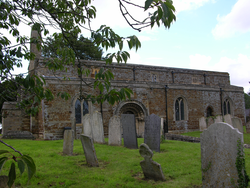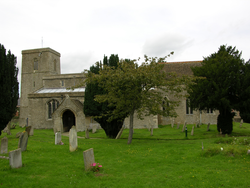
The Corpus of ROMANESQUE SCULPTURE in Britain & Ireland

Peterborough (now)
Chapel
St Mary's is a cruciform church to which a three-bay south nave aisle, with an arch to the transept, was added
in the early 13thc. The nave has a 15thc.-16thc. clerestorey on the S wall only. The N transept now houses the
organ, and its arch is 13thc. and pointed, but the transept itself is a modern
rebuild. The S transept arch is late 12thc. and round-headed. The
chancel belongs to the early 13thc. too, but its S
doorway is, stylistically at least, late 12thc., and is included here. The W
tower was rebuilt in the 16thc., and its arch is of reused material. The south
nave doorway is 13thc., under a porch bearing a date
stone of 1662. There is no N doorway. Construction is of stone rubble, much
disturbed. Features described here are the S transept arch and the S
chancel doorway.
Chapel
St Mary's has an aisled and clerestoreyed nave with three-bay
arcades. Of these bay 1 of the S arcade is 13thc. and may, according to Pevsner, have been a
transept arch originally. The rest of the S arcade and the
entire N arcade are either 19thc. in their entirety or heavily
restored work of the years around 1300. The clerestorey windows
are 14thc. The S aisle has been extended E alongside the chancel
to form a chapel, now in use as an organ loft and vestry. The
chancel also belongs to c.1300. At the E end the
lowest part of a tower remains, including a 14thc. window. The spire had fallen in 1703,
and most of the remainder was demolished in 1967. In its place a bellcote was built on top of the west gable. A
date stone of 1601 over the S doorway presumably records a restoration. The church is of
ironstone and grey stone in roughly-coursed blocks. The only Romanesque feature is the
elaborate late 12thc. S doorway.
Chapel
St Leonard's has a four-bay clerestoreyed nave, the arcades divided into two two-bay sections by a short stretch of wall. In the N arcade all the arches are pointed and the capitals moulded; in the S the E bays are similar, but the W bays have round arches. Nevertheless both arcades are 13thc., but for two features. The base of N pier 3 is a reused, inverted multi-scallop pier capital (or, as Pevsner suggests, a pair of respond capitals), and chevron voussoirs have been cut down for reuse in the E arches of the S arcade. For the rest, the chancel is 13thc. and there is a low W tower, late 13thc. in its lower parts and Perpendicular above.
Chapel
St Mary's has a nave with a two-bay N aisle without any windows and a S doorway under a porch. The square-ended chancel has a N vestry and organ chamber, and there is a W tower with a broach spire with two tiers of lucarnes. An 11thc. window in the W wall of the nave indicates an early date for the core building. The S doorway dates from the early 13thc., and the N arcade and tower are slightly later. The S porch is dated 1663, and at that date too the S nave wall was rebuilt. The clerestoreys to N and S were presumably added at that time too. At some point, probably in the 15thc., the chancel fell down, and the E nave wall was rebuilt without a chancel. Until the new chancel was built in 1902 on the old foundations, St Mary's was claimed to be the smallest parish church in England. Construction is of stone rubble and ashlar. The church boasts an exceptional font of the 1120s, which is the only feature described here.
Parish church
Brigstock is toward the N of the county, 6 miles NE of Kettering. It is a substantial
village lying in the valley of Harper's Brook, a tributary of the river Nene. The
settlement is an ancient one, and a good deal of Roman material has been found around
the village. It is within Rockingham forest; a royal hunting ground created by
William I, but by no means entirely wooded even then. The church is in the centre of
the village, alongside the brook. St Andrew's has a tall 11thc. nave with a blocked
window remaining in the N wall. N and S aisles have been added, with three-bay
arcades; the two western bays of the N
arcade 12thc., the E bay and the
entire S arcade are 14thc. The S doorway is of c.1200, under a Perpendicular porch. The chancel arch is tall and Perpendicular, but the chancel itself has a N chapel with a two-bay 13thc.
arcade and a S chapel now housing the organ. The N chapel
contains the tomb of Robert Vernon, first Baron Lyveden (d.1873) with a marble
effigy. The nave aisles extend westward alongside the tower, and it is this for which
the church is known. The tower arch is tall and round-headed; the tower originally
short and of rubble with long-and-short quoins. There is a
rough round-headed window high on the N face. A round stair turret is attached to the W wall, entered from within by a triangular-headed
doorway. A completely plain round-headed arch, probably 12thc., links the tower and
the N aisle extension. To the 11thc. tower has been added a 14thc. storey of ashlar
and a broach spire with three rows of lucarnes. The church was restored by Carpenter
(1876-77). The tower arch is described here, although it is probably pre-Conquest.
Also recorded are the 12thc. parts of the N arcade and the S
doorway.
Parish church
All Saints, Brixworth is essentially an Anglo-Saxon church, described by
Clapham as 'perhaps the most imposing architectural memorial of the seventh
century surviving north of the Alps'. The date is based on the 12thc.
Peterborough chronicle of Hugh Candidus, who attributed its foundation to
Cuthbald, abbot from 675. Fernie (1983) preferred a date between 800 and 860 on
the basis of continental parallels, particularly for the exterior ring crypt,
the square choir bay preceding the apse, and the probable original form of the
wall between nave and choir. The church has a long, unaisled nave of four bays,
these marked by wall arches of brick now containing windows. These arches
originally led into flanking spaces divided into porticus. East of the nave is
the square choir bay, now entered under a broad 15thc. arch, and east of this
the apse with three windows. From the exterior the apse is polygonal, but this
is a 10thc. modification; it was originally semicircular. Here too can be seen
the remains of the ring crypt, original to the design and formerly
barrel-vaulted. On the S side of the square choir bay is a chapel of
c.1300. At the west end signs of a late 10thc. remodelling are also
visible. The west porch was heightened into a tower and a window into the nave
added, and on the west wall of the tower a stair turret was added. The tower
was heightened again and a spire added in the 14thc. The church is included
here on the grounds of a late-Romanesque doorway inserted into the west arch on
the S side of the nave.
Parish church
St Andrew's has a clerestoreyed and aisled nave with three-bay 14thc. arcades. The chancel and its arch are 14thc. too, as are the clerestorey and the aisle windows. The chancel was in fact rebuilt in 1828. The W tower is of c.1300, and has a broach spire. What remains of the 12thc. church is the masonry at the SW angle of the nave and the S doorway, now reset and protected by a porch.
Parish church
The church has a nave with a 13thc. south aisle extended west alongside the tower, no clerestorey, a chancel and west tower. The 13thc. nave arcade is three bays long. In the aisle is a late-12thc. doorway under a porch. The north doorway is later and has no porch. The tower is 13thc. in its lower parts, with early 14thc. bell-openings. Construction is of stone rubble. The only Romanesque element is the plain S doorway.
Parish church
St Andrew's has an aisled and clerestoreyed nave with four-bay arcades; the N of the late 12thc., the S 13thc. with pointed arches and moulded capitals. The N and S doorways are 12thc., the N doorway under a porch. The aisle windows are renewed in an early 14thc. style. At the E end of the nave, above the chancel arch, is a large blocked window, apparently 14thc. The chancel has 14thc. sedilia. On the N side of the chancel, and separated from it by a two-bay arcade, is a chapel added by John Chambre between 1495 and 1505, now housing the organ and a vestry. This extends the N nave aisle as far as the E end of the chancel, but is screened from it. There is a 12thc. W tower with a contemporary tower arch. It is of three storeys; the lowest containing an elaborate W doorway and a blind arcade on the W face only, the next decorated with blind arcading, and the topmost with double bell-openings flanked by blind arches and a corbel table at the top. The belfry-stage lancets are Scott's replacements of Decorated windows (see Parker). It has a later recessed spire behind a battlemented parapet. The church was restored by Scott before 1849.
Parish church
St Mary's has an aisled, three-bay clerestoreyed nave with 14thc. arcades, an aisleless chancel and a W tower with a broach spire having two rows of lucarnes. The N doorway is plain, and the elaborate 13thc. S doorway is covered by a porch. A vestry has been added to the N of the tower. The church is constructed of roughly shaped grey stone with remains of mortar render on the chancel. The spire collapsed in 1877, and the tower was rebuilt in 1880-83. Romanesque interest centres on the three-storey tower and its arch. A 12thc. S window survives on the first storey, and the third-storey bell-openings are also 12thc. in design, although not all are original. Traces of beading survive on a stone reused in the fabric of the chancel.









